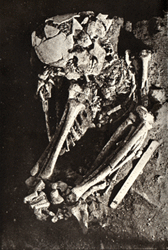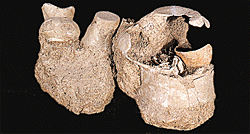 
Respect towards human life and its fate after death is already manifest from the Palaeolithic Period and has been documented in Greece with isolated burials in caves, as well as with group burials, known from the Mesolithic Period. During the Neolithic Period the dead were buried inside their houses -beneath the floor- or very close to them, at the limits of the settlements they had lived in. Burials were as a rule isolated, while cemeteries have rarely been encountered; the latter date from the Early (Soufli Magoula), Late (Soufli Magoula, Platia Magoula Zarkou) and Final Neolithic (Kephala-Kea, Tharrounia-Euboea, Yiali-Dodecanese). |
There is evidence of three types of burial customs from excavations carried out in Greece: 1. Primary internment of the dead in simple pits (simple inhumations), usually in a contracted but also crouched position 
2. Cremation of the dead, partial (Early Neolithic) or complete (Late
Neolithic), accompanied by vases, or cremations in which the cremated
were in several cases placed in vases, the first known in Greece and some
of the oldest in Europe, and Burial practices reflected the beliefs of Neolithic society concerning death, which was not considered as simply a form of sleep continued inside the house of the dead, beneath the floor where their kinship continued their activities. Burial offerings of vases and other objects on the charred bodies of the dead suggests in fact a belief in life after death, in the immaterial and therefore indestructible soul! |